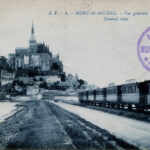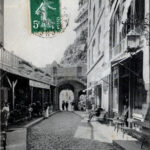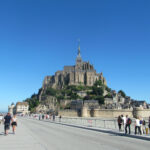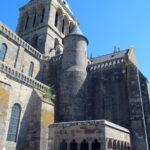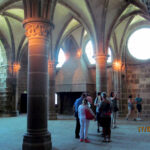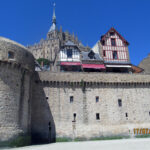Le Mont-Saint-Michel (English: Saint Michael’s Mount) – an ancient monastery, abbey, and fortress, all situated on an imposing tidal island. A stunning blend of stark architectural and natural beauty, the island is a unique wonder of France, with over a thousand years of history behind it.
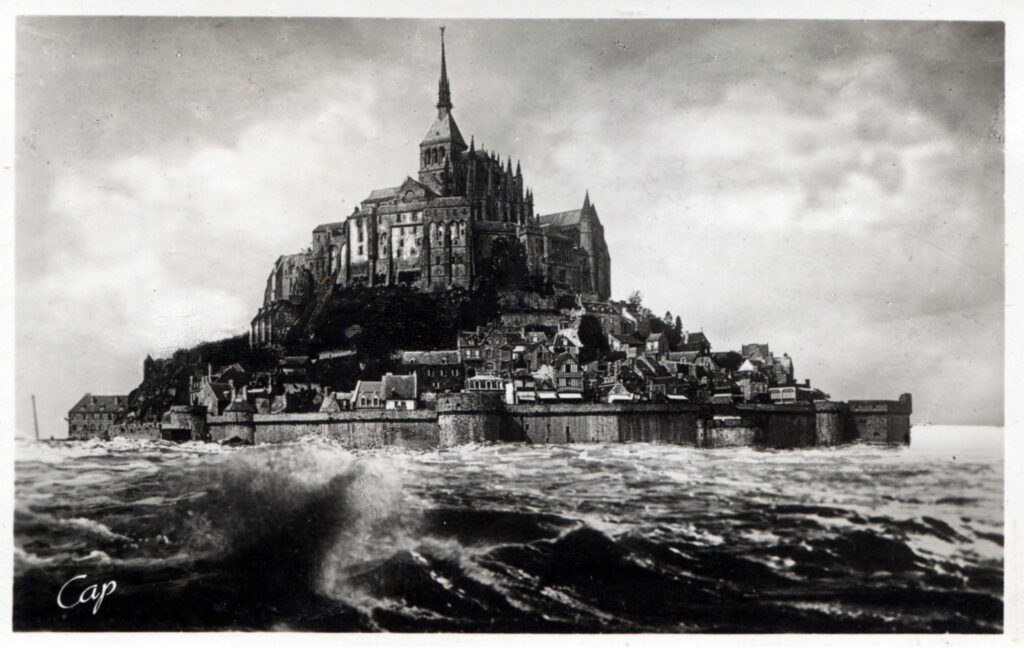
Mont-Saint-Michel is a unique combination of an abbey and a fortress, towering above the waves at high tide (postcard from the early 20th century, author’s collection)
Mont-Saint-Michel is built on a rocky granite island 400 kilometers northwest of Paris, on the border of Normandy and Brittany. The island sits in a tidal bay fed by three rivers, where at low tide the island is connected to the mainland by a thin flat of silt, but at high tide it is completely disconnected from the mainland, apart from a small bridge. Occupying a strategic location in the English Channel, this island was an important fortified area and fortress for most of its history. Today, the island has become a popular tourist destination for those interested in experiencing its unique history and beauty.
According to legend, in the year 708, the Archangel Michael appeared in the dreams of the Bishop of Avranches Saint Aubert and commanded him to build a church upon the rocky island that would become Mont-Saint-Michel. The bishop hesitated, fearing the dream to be a demonic manifestation, so Micheal appeared again the next night to command that the church be built. But Aubert hesitated again in fear, and so Michael appeared for a third night, poking the bishop in the head as he repeated his command. The touch of the Archangel stunned the bishop, leaving a hole in his skull. Thus, on October 16th, 709, a new church was consecrated on the island. (Saint Aubert’s purported skull, complete with hole, is on display at the basilica in Avranches just south of Mont-Saint-Michel.)
In 966, at the request of Richard the Fearless, the Duke of Normandy at the time, the church was occupied by a community of Benedictine monks from Italy. The island’s position off the mainland allowed for a secluded monastery to develop, while still being accessible to traveling pilgrims and scholars at low tide. Simultaneously, the island’s defensibility was recognized by medieval strategists, and the island began to be fortified with walls and battlements so as to serve as a strongpoint on the Norman coast. The island appears as such on the famed Bayeux Tapestry, as a point on the journey of the Normans to conquer England. The monastery prospered in the decades to follow, as it had supported the claims of William the Conqueror, the new king of England. Later, in the 12th century a set of Norman Romanesque monastic buildings were constructed on the western and southern portions of the island. In the 13th century, the French king Philip Auguste captured Normandy and his Breton soldiers burned Mont-Saint-Michel, as the Bretons were the historic rivals of the Normans and Mont-Saint-Michel was a point of contention on the border between the two regions of Brittany and Normandy.
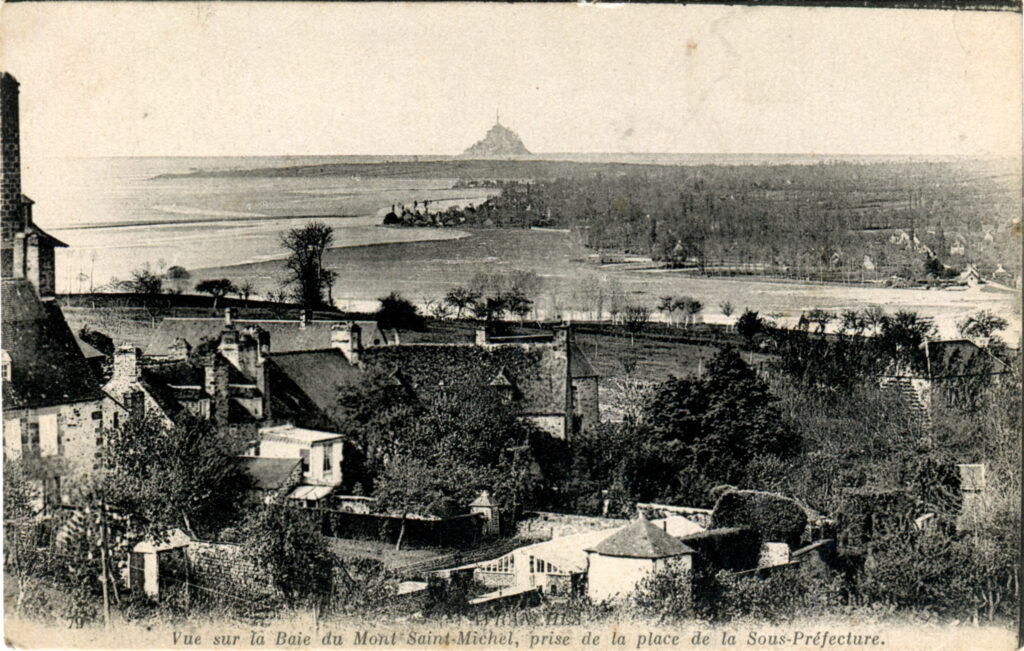
Saint Michael’s Mount (French Le Mont-Saint-Michel) fortress, seen from the western coast of the bay. (Postcard, probably pre-First World War)
During the Hundred Years War, the English tried twice to besiege the abbey, but failed to capture the island both times. Two wrought iron cannon bombards abandoned by the English after the second siege in 1434 are proudly displayed on the island. However, in the course of the sieges most of the island city was destroyed. The Romanesque choir of the abbey church, demolished in the first siege in 1423, was replaced by a Gothic one at the end of the Middle Ages. Despite this, the church of Mont-Saint-Michel grew in prominence, becoming a renowned site of pilgrimage on the network of pilgrimage paths known as the Way of St. James. From this network, the church became linked with Catholic sites across Western and Central Europe, becoming a part of what was often known as “the road of Paradise.” To this day, more than a thousand years later, the monastery and church on Mont-Saint-Michel continues to receive pilgrims from across Europe.
Following the French Revolution in 1789, which was as opposed to the dominance of the Catholic Church as it was the tyranny of the monarchy, Mont-Saint-Michel was seized by the revolutionary regime and converted into a prison. The prison used the fortified abbey to hold political prisoners, especially high-profile political dissidents and opponents of the new state. The conversion into a prison was heavily criticized by the French intellectual establishment, and by the mid-1830s a campaign was underway by figures such as Victor Hugo to restore Mont-Saint-Michel as an architectural wonder of France. Hugo glorified the island in his writings as the “Pyramid in the Ocean.”
By 1863, the movement succeeded, closing the prison. However, during those decades almost every structure on the island had deteriorated, with some threatening collapse. It was the work of architect Édouard-Jules Corroyer, who first inspected the island in 1872 and became infatuated with its beauty, that brought the island back from the brink. Corroyer led a fifteen year restoration project funded by the French state beginning in 1874. The restoration was entrusted to the State Service for the Preservation of Historical Monuments, with major repair works concluded by the end of 1889. One major change to Mont-Saint-Michel was the construction of a dam and causeway to the island, accessible at low tide. While the dam works improved the island’s accessibility, they had an unfortunate side effect. By blocking the tide from removing the silt deposited around the bay, the silt built up over the decades and eventually connected with the mainland, turning Mont-Saint-Michel into a peninsula instead of an island.
Mont-Saint-Michel was thankfully spared the horrors of the two World Wars. As the D-Day landings occurred in central Normandy, east of the island, the German occupiers chose to abandon the site, as they would soon be cut off and isolated by the Allied invasion force. Mont-Saint-Michel was thus liberated by a single American soldier, Private Freeman Brougher, and two British war correspondents, Gault MacGowan and Paul Holt. The three men were welcomed with jubilant crowds of locals from the island and nearby Avranches, and signed the island’s traditional register of visiting nobility, the Golden Book.
The celebration of the millennium of monasticism at Mont-Saint-Michel in 1966 preceded the formation of a new religious community in the abbey, so as to perpetuate the original purpose of this place. The Brothers and Sisters of the Monastic Brotherhoods of Jerusalem have confirmed this spiritual presence since 2001, and a small community of monks are still the main residents of Mont-Saint-Michel.
The abbey and the historical complex of Mont Saint-Michel was included in the UNESCO World Heritage of Humanity List as a protected monument in 1979. The French proudly call it “the eighth wonder of the world,” and more than one and a half million tourists visit it every year. Cinematography of the twentieth century has noted the virtues of the sacred rocky island, such as the 1975 French comedy Incorrigible (Directed by Philippe de Broca & Jean-Paul Belmondo). Mont Saint-Michel’s awe-inspiring architecture also inspired the look of the fortress of Minas Tirith in Peter Jackson’s The Lord of the Rings movie trilogy, based on the books by J. R. R. Tolkien. For 21st century contemporaries, the sacredness of the monastery and the attraction of pilgrims are already being replaced in part by the curiosities of contemporary art. The famous English composer-instrumentalist Mike Oldfield dedicated a song to the island in the album Voyager.
In order to restore Mont-Saint-Michel as an island again, the old causeway was carefully removed between 2009 and 2014, and a new dam was constructed that does not restrict the scouring action of the tides. A new bridge was also installed in the place of the old causeway, allowing access to the island. By 2022, the project had proven successful, with much of the accumulated silt washed out and dispersed into the ocean. President of France Emmanuel Macron visited the island in 2023 to commemorate the island and celebrate its restoration to its natural state.
- Traveling to Mont Saint-Michel by train across the causeway before the First World War
- Hotel Poulard, Mont Saint-Michel
- The same view of Mont Saint-Michel today
- Towers and a giant caged eagle
- Visiting and exploring the buildings inside
- View of the fortress of Mont Saint-Michel from the Northern side
- Wall with gun loopholes, Mont Saint-Michel is a military engineering marvel of the early Modern era.
Museum and the tourist practical information:
The abbey is open to visitors all year round, except on December 25, January 1 and May 1. Opening hours in summer are from 9:00 to 19:00 (7:00 PM); in winter they are from 9:30 to 18:00 (6:00). The entrance fees are as follows: 9 euros for adults, 5.5 euros for young people (those under 25), and children under 18 are free. Masses are held in the cathedral every day except Mondays. On Sundays the service starts at 11:30, on other days it starts at 12:15. If you want to attend Mass, you must arrive 15 minutes before the start, as entry is prohibited during the service.
On the coast of the bay of Mont Saint-Michel, the tide schedule is in all public places: in hotels, restaurants and beaches. It can hardly be said that the tides are very dangerous – the water rises at about the speed of a walking pedestrian. During full moons and equinoxes the tide will rise up somewhat faster and higher than normal, so warnings are posted everywhere to ensure that tourists are not too far out on the bare seabed on these days. The new bridge constructed in 2014 guarantees safe and easy access to the island. In general, this part of the coast is famous for its strong tides: the water level rises by 12-15 meters every day, and due to the flat sandy bottom, it recedes back at low tide by 15-20 kilometers. The spectacle is extraordinary!
The tour to the abbey of Mont Saint-Michel starts on the southern slope of the mountain and goes through the real medieval city, surrounded by a powerful fortress wall. Compare the fortifications in the photos during high tide and after low tide. It is interesting to see the view of the abbey a hundred years ago on an old photo postcard before starting the trip.
Behind the stone royal gates begins the Grand Rue, the city’s central artery. Past restaurants, hotels and numerous souvenir shops, it leads to the tower from which the stairs leading to the abbey begin. The climb is quite long and tiring, so if you are traveling with a child, it may be wiser to limit yourself to the lower town.
At the Mont Saint Michel Museum you will see:
* A thousand years of history of the abbey and fortress
* Preserved medieval dungeons, and cells from the Revolution
* Church buildings and towers in English Romanesque, Gothic, and Neo-Gothic stylings
* Panoramic views of the surroundings of the bay with ebbs and flows
Beach holidays, swimming. Recently, there has been literally an influx of tourists who like to combine the educational and the enjoyable. Mont-Saint-Michel and the surrounding beach communities allow one to relax on local beaches after touring the one-of-a-kind medieval buildings. In summer, everyone likes to wander along the coast, sunbathe, and in some places even swim at high tide.
Tours with children, schoolchildren, or Christian youth.
For several centuries, pilgrims from all over the world have been coming here with their children, educating them in the spirit of traditional Christian values. The abbey of Mont Saint Michel is an object of world history and interesting for today’s youth. Today the island is a favorite place of pilgrimage for Christian youth organizations: scouts, Orthodox knights, the Christian Union of Young People and other associations.
See also
- Sightseeing or WW2 battlefield private tours to Normandy from Paris, from Charles de Gaulle airport (Orly, Beauvais) or Disneyland for one day or 2-3 days with an overnight stay along the route.

